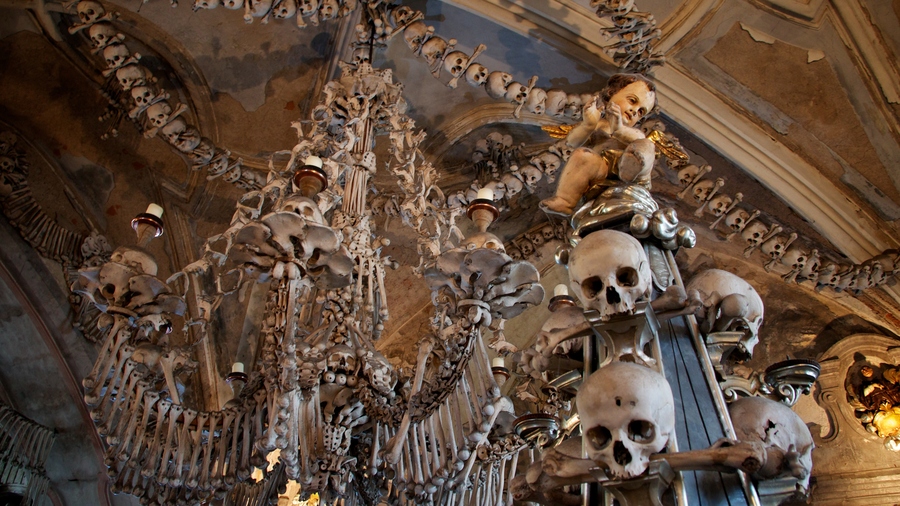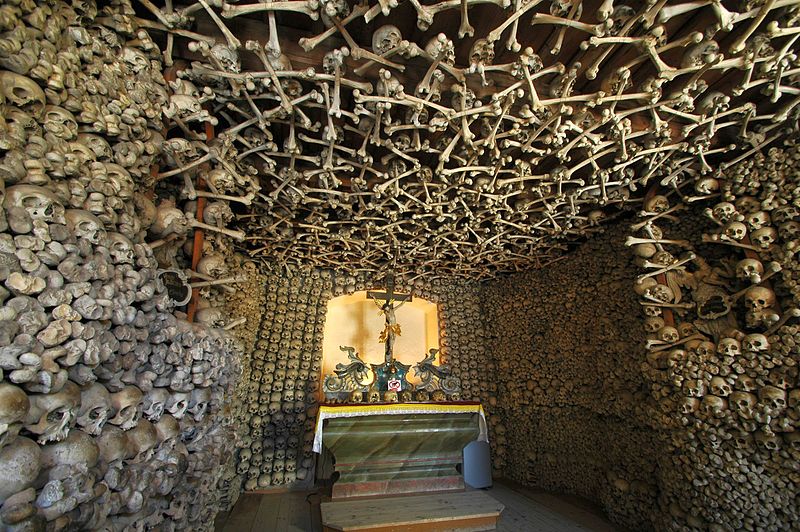Imagine this: You’re a priest in charge of an important church during a plague. All around you, people are dying in their thousands and their tens of thousands. Your duty is to give these poor souls a proper, Christian burial. But the churchyard is full, the catacombs under your church are full. What do you do?
Well, if you have a particularly macabre and creative streak, you take some of these bones, and you use them to decorate your church. Pelvic bones become a chandelier, cornices become lines of skulls, church pews outlined in finger bones … these churches become ossuaries (final resting places for skeletal remains), and serve as a daily reminder to the congregation about the fragility of life.
Throughout the world, many of these bone churches still survive, and a travelling goth can sample some of the best. Here are my favourite bone churches of the world:
Sedlec Ossuary, Czech Republic
 Located in a small suburb of Kutna Hora, the Sedlec Ossuary is perhaps the most well-known bone church on this list. The church was started by a monk named Henry, who went on a pilgrimage in 1278 to Jesus’ burial place and brought back a small container of earth. He sprinkled some of the earth on the site, and it became holy ground. The church was built and anyone who was anyone wanted to be buried there. But as the plague hit, the cemetery ran out of room, so graves were dug up and the bones moved to the church.
Located in a small suburb of Kutna Hora, the Sedlec Ossuary is perhaps the most well-known bone church on this list. The church was started by a monk named Henry, who went on a pilgrimage in 1278 to Jesus’ burial place and brought back a small container of earth. He sprinkled some of the earth on the site, and it became holy ground. The church was built and anyone who was anyone wanted to be buried there. But as the plague hit, the cemetery ran out of room, so graves were dug up and the bones moved to the church.
In 1511 a monk stacked the bones in high pyramids inside the church, but in 1870, the famous woodcarver Frantisek Rint rearranged the bones of more than 40,000 souls into the artful displays seen today. Most famous are the chapel’s chandeliers, made using every bone in the human body.
Basilica of St. Ursula, Cologne, Germany

Built upon the ruins of a Roman cemetery, the Basilica of St. Ursula is famous for a beautiful reliquary (a place housing relics) created from the bones found in a mass grave in the cemetery. In 1155, a mass grave was found, and the victims were assumed to be the remains of St. Ursula and her 11,000 virgins, who were allegedly slaughtered by the Huns. So the walls of the “Golden Chamber” were decorated with the remains, creating beautiful patterns of swirls and zigzags, as well as Latin words.
Santa Maria della Concezione, Rome
 In this church, the bones of more than 4,000 Capuchin friars who served the congregation between 1500-1870. The bones are arranged in the highly decorative rococo style, with several friars complete and dressed in their robes. A plague in the entrance of the church declares “What you are now, we once were; what we are now, you shall be.”
In this church, the bones of more than 4,000 Capuchin friars who served the congregation between 1500-1870. The bones are arranged in the highly decorative rococo style, with several friars complete and dressed in their robes. A plague in the entrance of the church declares “What you are now, we once were; what we are now, you shall be.”
Czemna Chapel, Poland
A local priest and a gravedigger joined forces in 1776 to dig up some of the mass graves around the area (including those from the Thirty Years War and Silesian Wars). Altogether, they removed around 24,000 skeletons. Most of these bones are arranged in an underground crypt, but a beautiful chapel was also constructed, called the “sanctuary of silence”, where more than 3000 bones – including the skulls of the artists themselves – are beautifully arranged.
Have you ever visited a bone church or an ossuary? What did you think?
Photos from Wikimedia Commons



Also, there’s the Capela dos Ossos (bone chapel) in Évora, Portugal. In the entrance you have the most awesome phrase for a bone chapel ever written: “Nós ossos que aqui estamos, pelos vossos esperamos” (something like “we bones that were already here, for yours we are waiting”)